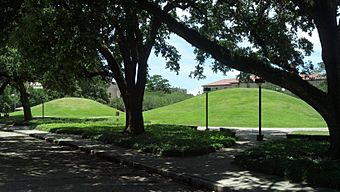LSU Campus Mounds facts for kids
Quick facts for kids |
|
|
LSU Campus Mounds
|
|
 |
|
| Location | Along Field House Drive, on Louisiana State University Campus, Baton Rouge, Louisiana |
|---|---|
| Area | 2 acres (0.81 ha) |
| Architectural style | Earthen mounds |
| NRHP reference No. | 99000236 |
| Added to NRHP | March 1, 1999 |
The LSU Campus Mounds, also known as the LSU Indian Mounds, are two very old hills built by Native American people. You can find them on the campus of Louisiana State University in Baton Rouge, Louisiana.
These mounds are about 20 feet (6 meters) tall. Scientists believe they were built during the Archaic Period. This was a time long ago when people in North America were mostly hunters and gatherers.
Many people think these mounds are more than 5,000 years old. Some experts even suggest they could be 11,300 years old! This would make them older than the famous Great Pyramids of Egypt. They might even be the oldest human-made structures still standing in all of the Americas, or even the whole world.
Contents
History of the LSU Mounds
These ancient mounds were built thousands of years ago. They are located on a spot that looks over the Mississippi River floodplain. A floodplain is a flat area of land next to a river that often gets flooded. Today, this spot is where Louisiana State University is located.
The northern mound is made of hard clay dirt. The southern mound is more porous, meaning it has tiny holes that allow air or water to pass through. Experts believe these mounds were used for special ceremonies. They may have also served as important markers in the landscape. They are part of a larger system of similar mounds found across Louisiana.
How Old Are the Mounds?
Scientists first tried to figure out the age of the mounds in 1982. In 2009, a professor named Brooks Ellwood took small samples from inside the mounds. These samples are called "core samples." He found a layer of charcoal, which is like burnt wood. This charcoal might have come from an old pit barbecue or a cremation. Cremation is when a body is burned.
More digging and study happened in 2011, 2012, and 2018. Based on what he found, Professor Ellwood thinks the mounds might contain the remains of cremated people. He also believes they are much older than previously thought, possibly as old as 11,300 years.
Protecting the Mounds
Because the mounds are in a busy part of the university campus, they started to show signs of wear and tear. This is called "degradation." Natural erosion (when wind or water wears away the land) also caused damage.
To help protect them, the university added a sidewalk between the mounds in 1985. They also built a low brick wall around them. This wall helps stop cars from driving too close and damaging the mounds.
Restoration Efforts
Even with these efforts, erosion continued to cause problems. So, in 1996, a project began to fix the damage. This is called a "restoration project." Workers used river silt (fine dirt from a river) to patch up damaged areas on both mounds. They also planted a special type of grass called Bermuda grass. This grass helps hold the soil in place and prevents future erosion.
The LSU Campus Mounds were officially added to the National Register of Historic Places on March 1, 1999. This list includes important historical places in the United States.
In 2010, LSU started a campaign called "Save the Mounds." University officials said the mounds had internal structural damage. This means the inside of the mounds was getting weak, which could cause them to collapse. The mounds used to be popular spots for tailgate parties before football games. But since 2010, fences are put up around them during home football games. This helps protect them from being damaged by large crowds.



